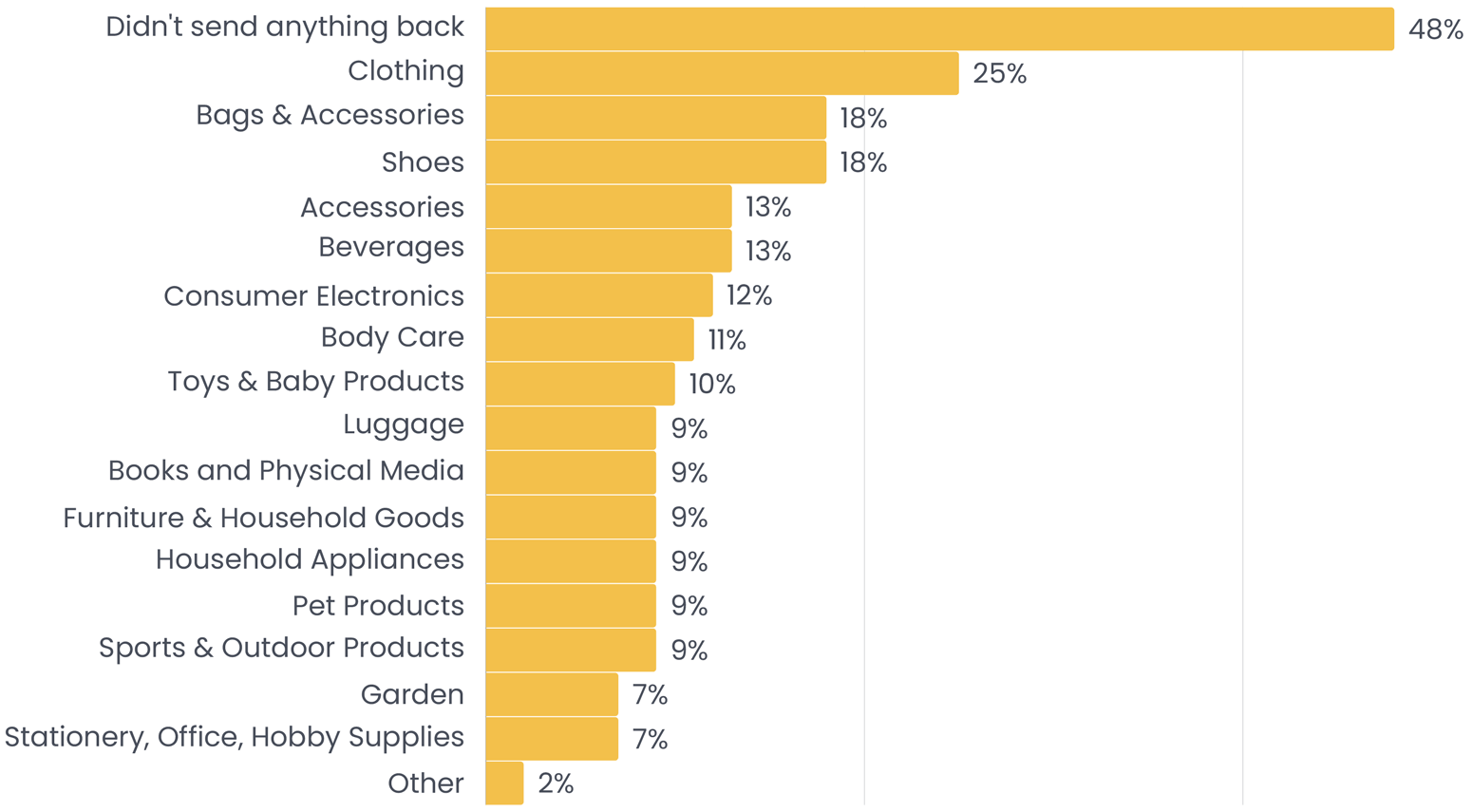🔙 Retailers guide to “eCommerce returns management”.
Ecommerce returns are an inevitable part of online retail. The nature of online shopping, where customers cannot physically interact with products before purchase, contributes to a higher rate of returns compared to traditional brick-and-mortar stores. The ecommerce return rates varying between 5% to 25% based on the product category, underscore the significance of an efficient return management process.
While there are many reasons for ecommerce returns ranging from product dissatisfaction to shipping errors, the way an ecommerce returns are managed can profoundly impact customer satisfaction and loyalty. Effective handling of the return process – which includes the intake of returned products, processing refunds, and managing reverse logistics – is not just about rectifying a transaction. It’s an opportunity to reinforce trust and build a lasting relationship with customers leading to higher LTV.
Understanding that returns are a part of the online shopping experience and integrating them seamlessly into your business operations is crucial. This approach not only helps in maintaining a positive brand image but also in converting potentially negative experiences into opportunities for customer engagement and retention. By focusing on a customer-centric returns policy, making the return experience straightforward for customers, and streamlining the reverse logistics process, e-commerce businesses can turn the challenge of returns into a strategic advantage.
Dissecting Returns Statistics
Understanding customer behavior around ecommerce returns is vital for retailers. Data from a 2023 online survey indicates that clothing tops the chart, with 25% of U.S. respondents noting it as the most returned category. This isn’t particularly surprising, given the challenges customers face when trying to gauge fit, texture, and true color through a screen. Other categories like bags & accessories, and shoes also see high return rates, likely for similar reasons.

But not all categories suffer the same fate. Items less frequently returned, such as garden supplies or stationery, suggest that these products may have clearer expectations in the online marketplace or that they suffer less from subjective evaluation.
Reasons for eCommerce returns: Why Customers Return Online Purchases
Transitioning into the reasons behind ecommerce returns, several factors come into play:
- Fit and Size Issues: Particularly prevalent in clothing and shoes, where customers can’t try items on before purchasing.
- Product Expectations vs. Reality: Images and descriptions online may not always match the received product’s look or feel.
- Product Performance: Especially in electronics and appliances, where functionality may not meet the customer’s needs or expectations.
- Damaged or Defective Items: Shipping and handling can sometimes lead to items being damaged upon arrival.
- Shipment Delays: Unmet delivery expectations is another major contributor to ecommerce returns and customer dissatisfaction. Transparency is key—providing customers with realistic delivery windows and keeping them informed of any changes can mitigate these issues.
- Product No Longer Wanted/Buyer’s Remorse: Often, customers make impulse purchases and later realize that the product doesn’t suit their needs or preferences, leading to returns.
Preventing Unnecessary eCommerce Returns
Having explored the varied reasons why customers return their online purchases, it becomes imperative to transition from understanding to action. The following collection of targeted strategies designed to address these specific issues. By aligning our preventive measures with the underlying causes of ecommerce returns, retailers can create a more efficient, customer-centric shopping experience that not only reduces return rates but also strengthens customer trust and loyalty.
Fit and Size Issues management to minimize online returns
- Measure Accurately: Use standard measurement units (inches, centimeters). Measure key areas: for apparel, chest, waist, hips, and length; for boots, foot length, width, and calf circumference.
- Include International Conversions: Provide conversion tables for different regions (US, EU, UK, etc.). This not only helps international customers choose correctly, but provide another level of reference to domestic buyers.
- Use Visual Aids: Include diagrams or images showing measurement points. This clarifies where and how to measure.
- Offer Comprehensive Size Ranges: When catering to diverse body types, include a wide range of sizes and fits (petite, plus-size, wide-fit for boots).
- Update Regularly: Keep charts current. Update them if there are changes in sizing standards or product design.
- Provide Fit Descriptions: Besides measurements, describe the fit (e.g., slim fit, regular, wide fit for boots). This helps customers understand the style and fit better.
- Include User Feedback: Feature customer reviews focusing on fit and sizing. Real user experiences can guide new customers.
- Easy Access on Website: Make size charts easily accessible on product pages. Avoid hiding them in obscure sections.
- Offer Customer Support: Provide a channel for sizing inquiries assisting in choosing the correct size.
- Use Adjustable Features: For boots, consider adjustable elements like laces or straps. This can accommodate different fits.
- Implement Size-Based Filtering and Product Recommendations: Add a feature allowing customers to filter products by size. Additionally, display related items that complement their choice. This not only assists in finding the right fit but also encourages buying complementary products, potentially increasing the average order size. This strategy can have positive effects, even in the case of returns
- Partial Returns Over Full Returns: Customers who buy multiple items that complement each other are more likely to keep at least some of the products, leading to partial rather than full returns.
- Increased Exchanges: When customers purchase coordinated items, they’re more inclined to exchange an item for a different size or color instead of returning it entirely. This keeps the sale intact while satisfying customer needs.
Remember, clear and detailed size charts reduce ecommerce returns, improve customer satisfaction, and enhance the shopping experience.
Reduce ecommerce returns with Product Descriptions, Images and Videos
Clear product descriptions and high-quality images are crucial. They enable informed decisions, reducing returns due to unmet expectations. Retailers must focus on practicality and customer engagement.
Product descriptions that reduce ecommerce returns
Accurate product descriptions are pivotal in addressing buyer needs and reducing return rates. The approach varies based on your customer base.
For Tech-Savvy Customers:
- Detail-Oriented Descriptions: If selling a gadget, include specifics like processor type, RAM, storage capacity, and compatibility features. For instance, a camera might have a detailed description of its sensor size, lens compatibility, and video resolution.
- Comparative Information: Tech-savvy customers often compare products. Provide comparison charts or links to similar products with different features or price points.
For General Consumers:
- Focus on Practical Benefits: Understand why customers buy your product. If selling a smartwatch, highlight how it tracks fitness, connects with smartphones, or its water-resistant properties, rather than just its technical specifications.
- Use Layman’s Terms: Avoid technical jargon. Describe a laptop’s long battery life and lightweight design over its technical specifications, which may be less relevant to a general audience.
For Specific Needs or Lifestyles:
- Lifestyle Alignment: Describe how the product fits into specific lifestyles. For a yoga mat, focus on its portability, durability, and comfort for yoga enthusiasts.
- Solving Problems: Highlight how a product solves specific problems. A vacuum cleaner’s description could focus on its efficiency in pet hair removal for pet owners.
Reducing Ambiguity:
- Clear Language: Use straightforward, unambiguous language. Ensure that the product’s purpose, use, and any necessary components or accessories are clearly stated.
- FAQs and Support: Include a section for frequently asked questions where customers can learn more about the product and its use. Provide easy access to customer support for further inquiries.
In every case, the key is to understand your audience and tailor the descriptions to meet their specific needs and expectations, thereby reducing ambiguity and enhancing their purchasing confidence. This approach significantly lowers the likelihood of returns due to misunderstanding or unmet expectations.
Importance of High-Quality Images and Videos in E-commerce
The use of high-quality images and videos is essential in e-commerce for providing customers with a clear and accurate representation of products. Here’s how to cater to different customer needs:
For Visually Driven Purchases:
- Detailed Images: For products where details matter, like fashion or jewelry, provide close-up images to show texture, material quality, and fine details.
- 360-Degree Views: Offer 360-degree images for products like furniture or electronics, allowing customers to view the item from every angle.
For Tech-Savvy Customers:
- Product Demos: Use videos to demonstrate the functionality of tech products. For example, a video showing the features of a smartwatch in action.
- Interactive Images: Use zoom-in features and interactive images that allow tech-savvy users to explore products in detail, like examining the ports and buttons on electronic devices.
For Lifestyle Products:
- Lifestyle Images: Display products in a lifestyle setting, like showing sports equipment in an outdoor setting or kitchen gadgets in a home kitchen.
- Storytelling Through Videos: Create videos that tell a story about the product, emphasizing how it fits into the customer’s lifestyle.
Product Use and Assembly
- Instructional Videos: For products requiring assembly, include videos demonstrating the process. This is particularly useful for furniture or complex gadgets.
- Usage Scenarios: Show the product being used in various scenarios, like a blender being used to make different kinds of foods.
Enhancing Relatability:
- Diverse Models: Use models of different ages, sizes, and backgrounds for products like clothing or accessories to show how they look on various body types.
- Customer-Generated Content: Encourage customers to submit their own photos and videos using the product, adding authenticity and relatability.
Quality and Consistency:
- High Resolution and Professional Quality: Ensure all images and videos are high resolution and professionally shot. Poor quality visuals can detract from the perceived value of the product.
- Consistency: Maintain a consistent style and quality across all product images and videos for a cohesive brand experience.
By carefully considering the type of product and the needs of the target audience, e-commerce businesses can use images and videos to effectively showcase their products, reduce ambiguity, and enhance the customer’s shopping experience. This approach not only helps in reducing ecommerce returns but also boosts customer satisfaction and trust.
Crafting an Effective Return Policy
An effective return policy can enhance customer satisfaction and loyalty, making it an important aspect of your post-purchase experience strategy.
To craft an effective return policy for your e-commerce business, follow these steps:
- Be Clear and Concise: Use simple language. Clearly outline what can be returned, the return timeframe, and the condition items need to be in.
- Flexibility and Fairness: An ecommerce return policy that balances customer convenience with business sustainability is key. Policies should be flexible enough to accommodate genuine customer needs while protecting the business from exploitation.
- Clarity and Accessibility: Return policies should be straightforward and easy to find. Clear communication on how and when items can be returned alleviates customer concerns and builds trust. Place your return policy in a visible spot on your website, like the footer. To further improve conversation rates place important excerpts on a checkout page to reduce hesitations and alleviate potential buyer’s remorse.
- Offer Free Returns: If possible, offer free returns to reduce purchase hesitations and increase customer trust. Offering free returns can be a deciding factor for some customers especially for most returned retail categories.
- Explain the Return Process: Detail the steps customers need to follow to return an item, including packing instruction. Outline the return procedure clearly, guiding customers on how to navigate to ecommerce return portal, obtain return labels and the return address. Despite WISMOlabs’ user-friendly process, a detailed guide helps set expectations pre-purchase, easing buyer concerns.
- Specify Refund Methods: Clarify the refund options, indicating whether refunds will be given as store credit or returned to the original payment method. Mention the expected timeline, for example, “Refunds are credited back to the original payment method within 14 business days of return receipt.” The duration varies from 1 to 14 business days, influenced by the merchant’s speed in requesting the refund from the bank, processing times of both the retailer’s and customer’s banks, and additional time for large or disputed transactions.
- Address Exchange Options: If you offer exchanges, explain how they work and any differences from the return process. Example: “To exchange an item, please return the original item for a refund and place a new order for the item you want.”
- Include Contact Information: If possible, show that you’re willing to support and assist through the return process by provide a way for customers to get in touch if they have questions or issues with their return.
- Regularly Review and Update: Ensures your policy stays relevant to customer needs and business goals and keep your policy competitive and up to date with customer feedback and industry standards to ensure it meets your business needs and customer expectations.
- Promote Sustainability: If applicable, include how returned items are handled to minimize waste and promote sustainability. This enhances brand image and attracts customers who value sustainability, potentially increasing your customer base.
- Highlight Any Exceptions: Prevents misunderstandings and manages expectations from the start. Clearly state any items that are non-returnable, such as personalized goods or sale items. This helps to reduce the likelihood of disputes and negative feedback, protecting your brand reputation.
A well-crafted return policy not only provides clear guidelines for your customers but also demonstrates your commitment to their satisfaction and trust. This approach can lead to a positive post-purchase experience, fostering a loyal customer base and differentiating your e-commerce business in a competitive market.
Logistics Management for Returns
Optimizing logistics management for ecommerce returns is a crucial aspect of the post-purchase customer experience in eCommerce. This process not only impacts customer satisfaction but also affects the retailer’s operational efficiency and bottom line. Retailers can improve their returns logistics through the management of shipping label generation, returns inspection, processing refunds, and managing exchanges.
Shipping returns
Consider the diversity of eCommerce returns management methods: direct returns to the retailer, through a third-party logistics provider, or donation for cost-prohibitive returns. Retailers must ensure an effortless return process, offering options like pre-included return labels or automated generation upon request, which can select the most cost-efficient shipping method. For added convenience, options include generating a QR code, eliminating the need for printing. Clear instructions should accompany these methods, guiding customers on how to package and where to drop off their returns, simplifying the process.
Receiving, Inspecting, Accepting, or Rejecting Returns
Once the return package arrives back at a warehouse or fulfillment center, the next critical step is the inspection process. This phase determines whether the returned item meets the criteria for acceptance or rejection based on the retailer’s return policy. Implementing a standardized eCommerce returns inspection process helps in maintaining consistency and fairness in handling returns. Training staff to effectively evaluate items for damage, wear, and completeness can streamline this process. Moreover, documenting the condition of returned items with photos or videos can provide a transparent basis for any decisions made regarding the return.
Processing the Refunds
After the inspection process, promptly processing refunds is key to maintaining customer trust and satisfaction. Retailers should aim to process refunds within a specified timeframe, typically a few days after receiving the return. Offering multiple refund options, such as store credit, exchange, or return to the original payment method, can enhance the customer experience. Automating the refund process as much as possible can reduce administrative overhead and minimize errors.
Managing Exchanges
Exchanges represent an opportunity to retain sales while satisfying customer needs. Efficiently managing exchanges requires a system that can quickly assess inventory levels and provide customers with alternatives if the original product is unavailable. This process should be as automated as possible, allowing customers to select their desired exchange item through an online interface and automatically generating a shipping label for the new item once the return is processed. Clear communication with the customer throughout the exchange process is essential to ensure their expectations are met.
Improving eCommerce returns management for returns logistics involves streamlining each step of the process to enhance efficiency and customer satisfaction. By automating shipping label generation, standardizing the inspection of returns, ensuring timely processing of refunds, and efficiently managing exchanges, retailers can turn the returns process into a positive aspect of the customer experience. Embracing technology and software solutions like WISMOlabs can provide the tools needed to achieve these goals, as evidenced by positive testimonials from retailers who have experienced the transformative impact of efficient returns management on their business.
eCommerce Returns Management Software: WISMOlabs Case Study
Key Functionalities: WISMOlabs offers automated ecommerce returns management software, real-time tracking, and detailed analytics, essential for managing returns effectively.
Ease of Use for Retailers and Buyers: WISMOlabs prioritizes a user-friendly interface, simplifying the return process for both customers and retailers, which can be a decisive factor in customer retention.
Integration with E-commerce Platforms: Its ability to integrate seamlessly with various e-commerce platforms allows for a unified and efficient post-purchase experience.
Impact of eCommerce Returns Management on Customer Loyalty and Lifetime Value
Building Trust through Transparency: Clear communication and transparency during the return process are paramount for building and maintaining customer trust.
Enhancing Customer Experience: A seamless return experience can turn a potentially negative situation into a positive one, enhancing customer satisfaction and encouraging repeat business.
Conclusion
In summary, eCommerce returns management, when executed with a focus on customer experience, significantly boosts retention and trust. A streamlined, positive eCommerce returns process directly influences customer loyalty and can even increase conversion rates by instilling purchase confidence.
Leveraging returns data offers insights for product and inventory optimization. Furthermore, incorporating technology in the returns process not only elevates efficiency but also ensures profitability, showcasing a retailer’s commitment to exceptional service and fostering lasting customer relationships.



